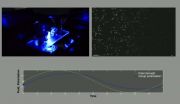(Press-News.org) BOSTON (June 5, 2015) - A daily sugar-sweetened beverage habit may increase the risk for non-alcoholic fatty liver disease (NAFLD), researchers from the Jean Mayer USDA Human Nutrition Research Center on Aging (USDA HRNCA) at Tufts University report today in the Journal of Hepatology.
The researchers analyzed 2,634 self-reported dietary questionnaires from mostly Caucasian middle-aged men and women enrolled in the National Heart Lunch and Blood Institute (NHLBI) Framingham Heart Study's Offspring and Third Generation cohorts. The sugar-sweetened beverages on the questionnaires included caffeinated- and caffeine-free colas, other carbonated beverages with sugar, fruit punches, lemonade or other non-carbonated fruit drinks. The participants underwent a computed tomography (CT) scan to measure the amount of fat in the liver and the authors of the current study used a previously defined cut-point to identify NAFLD. They saw a higher prevalence of NAFLD among people who reported drinking more than one sugar-sweetened beverage per day compared to people who said they drank no sugar-sweetened beverages.
The relationships between sugar-sweetened beverages and NAFLD persisted after the authors accounted for age, sex, body mass index (BMI), and dietary and lifestyle factors such as calorie intake, alcohol, and smoking. In contrast, after accounting for these factors the authors found no association between diet cola and NAFLD.
"Our study adds to a growing body of research suggesting that sugar-sweetened beverages may be linked to NAFLD and other chronic diseases including diabetes and cardiovascular disease," said first author Jiantao Ma, Ph.D., a former doctoral student in the Nutrition Epidemiology Program at the USDA HNRCA and a graduate of the Friedman School of Nutrition Science and Policy at Tufts University.
NAFLD is characterized by an accumulation of fat in the liver cells that is unrelated to alcohol consumption. NAFLD is diagnosed by ultrasounds, CT, MRI, or biopsy, and many of the approximately 25% of Americans with the disease don't experience any symptoms.* Being obese or overweight increases the risk for NAFLD and people with NAFLD are at greater risk of developing cardiovascular disease and type 2 diabetes.
Sugar-sweetened beverages are a major dietary source of fructose, the sugar that is suspected of increasing risk of NAFLD because of how our bodies process it. "Few observational studies, to date, have examined the relationship between sugar-sweetened beverages and NAFLD," Ma said. "Long-term prospective studies are needed to help ascertain the potential role of sugar-sweetened beverages in the development of NAFLD."
"The cross-sectional nature of this study prevents us from establishing causality. Future prospective studies are needed to account for the changes in beverage consumption over time as soda consumers may switch to diet soda and these changes may be related to weight status," added corresponding and senior author Nicola McKeown, Ph.D., a scientist in the Nutritional Epidemiology Program at the USDA HNRCA and an associate professor at the Friedman School. "Although there is much more research to be done, sugar-sweetened beverages are a source of empty calories, and people need to be mindful of how much they are drinking, perhaps by reserving this habit for special occasions."
INFORMATION:
The authors received funding from the National Heart Lung and Blood Institute's Framingham Heart Study (Contract N01-HC-25195), the Boston University School of Medicine and support from U.S. Department of Agriculture.
Ma, J; Fox, CS; Jacques, PF; Speliotes, EK; Hoffmann, U; Smith, CE; Saltzman, E; and McKeown, NM. "Sugar-Sweetened Beverage, Diet Soda, and Fatty Liver Disease in the Framingham Study Cohorts." Journal of Hepatology. June 5, 2015. http://dx.doi.org/10.1016/j.jhep.2015.03.032
*American Liver Foundation
For three decades, the Jean Mayer USDA Human Nutrition Research Center on Aging at Tufts University has studied the relationship between good nutrition and good health in aging populations. Tufts research scientists work with federal agencies to establish the USDA Dietary Guidelines, the Dietary Reference Intakes, and other significant public policies. The Gerald J. and Dorothy R. Friedman School of Nutrition Science and Policy at Tufts University is the only independent school of nutrition in the United States. The school's eight degree programs - which focus on questions relating to nutrition and chronic diseases, molecular nutrition, agriculture and sustainability, food security, humanitarian assistance, public health nutrition, and food policy and economics - are renowned for the application of scientific research to national and international policy.
BOSTON (June 5, 2015) -- A joint position statement outlining when, how and what type of Diabetes Self-Management Education and Support (DSME/S) should be delivered to patients is being released today at the American Diabetes Association's 75th Scientific Sessions. The statement is also being published online concurrently in Diabetes Care, The Diabetes Educator and the Journal of the Academy of Nutrition and Dietetics.
The statement -- written by representatives of the American Diabetes Association, American Association of Diabetes Educators (AADE) and the Academy of ...
Scientists have defined the smallest, most accurate thermometer allowed by the laws of physics -- one that could detect the smallest fluctuations in microscopic regions, such as the variations within a biological cell.
The research, involving mathematicians at The University of Nottingham and published in the latest edition of the journal Physical Review Letters, focuses on the sensitivity of thermometers made up of just a handful of atoms and small enough to exhibit distinctive 'quantum' features.
Devising sensitive and practical nano-scale thermometers would represent ...
Honest behavior is much like sticking to a diet. When facing an ethical dilemma, being aware of the temptation before it happens and thinking about the long-term consequences of misbehaving could help more people do the right thing, according to a new study.
The study, "Anticipating and Resisting the Temptation to Behave Unethically," by University of Chicago Booth School of Business Behavioral Science and Marketing Professor Ayelet Fishbach and Rutgers Business School Assistant Professor Oliver J. Sheldon, was recently published in the Personality and Social Psychology ...
This news release is available in German. Most magnetic materials have a structure that is somewhat more complicated than a commercially available domestic magnet: they not only have a north and south pole, but a variety of sectors, often only a few nanometres in size, in each of which the magnetic axis points in a different direction. These sectors are referred to as domains. Over the past few years, Manfred Fiebig, Professor for Multifunctional Ferroics at ETH Zurich, has been studying the walls between adjoining domains in certain materials. "The inner workings of ...
When a woman becomes pregnant or is planning a pregnancy, one of her first decisions is where she will deliver her baby. With options ranging from birthing centers to small community hospitals to regional health networks to academic medical centers, the decision can be confusing.
The question, especially for a woman with a low-risk pregnancy, is "What is the likelihood that something could go wrong?"
Research on this topic has been published in the American Journal of Obstetrics & Gynecology. The research was conducted by Valery A. Danilack, MPH, PhD, postdoctoral ...
Researchers from the UAB and the University of Nottingham, in an article published today in Physical Review Letters, have fixed the limits of thermometry, i.e., they have established the smallest possible fluctuation in temperature which can be measured. The researchers have studied the sensitivity of thermometers created with a handful of atoms, small enough to be capable of showing typical quantum-style behaviours.
The researchers characterised these types of probes in detail, devices which could provide an estimation of the temperature with a never before seen precision. ...
June 5, 2015 - Young infants who can "resettle" themselves after waking up are more likely to sleep for prolonged periods at night, according to a video study in the June Journal of Developmental & Behavioral Pediatrics, the official journal of the Society for Developmental and Behavioral Pediatrics. The journal is published by Wolters Kluwer.
"Infants are capable of resettling themselves back to sleep by three months of age," according to the study by Ian St James-Roberts and colleagues of the University of London. They add, "Both autonomous resettling and prolonged ...
Nanofibers -- polymer filaments only a couple of hundred nanometers in diameter -- have a huge range of potential applications, from solar cells to water filtration to fuel cells. But so far, their high cost of manufacture has relegated them to just a few niche industries.
In the latest issue of the journal Nanotechnology, MIT researchers describe a new technique for producing nanofibers that increases the rate of production fourfold while reducing energy consumption by more than 90 percent, holding out the prospect of cheap, efficient nanofiber production.
"We have ...
One mystery of birds' flight is solved! The elegance of birds' flight, their seemingly effortless aerial turns and the softness of their landing, have been envied by many people. From countless observations, it has been known that the birds use a small group of feathers, called "the alula", a thumb-like structure that is present at the bend of the wing, in slow and steep flight such as landing. Why do they use it? How the tiny feathers can help them land softly?
A recent article published in Scientific Reports says that the secret is a small vortex of air that is formed ...
Researchers from Uppsala University, together with colleagues at University College Dublin, have studied the dynamics of active swarms using computer simulations and experiments on unicellular algae. The team not only found full analogy of the active motion in a field to magnetic hysteresis but also managed to quantify the controllability of the swarm and identify the signatures of collective behavior of the active agents.
Active motion of living organisms and artificial self-propelling particles has been an
area of intense research at the interface of biology, chemistry ...

